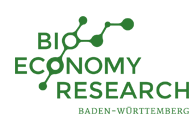BioChance - Impact of the bioeconomy on the environment and the water cycle - opportunities and risk minimisation

In this project we investigated how sustainable biomass production for the bioeconomy, based on a system analysis and an integrated land use concept, can be used in such a way that co-benefits are developed with water management and water protection. We focused on short rotation coppice (SRC) and combined fieldwork, laboratory analysis and computer modeling to develop a database of environmental impacts as a planning and decision tool (Figure 1).
We developed a new method to quantify groundwater recharge and solute fluxes using a novel experimental method, which also allows a retrospective determination for previous years. Soil samples were taken at eleven representative SRC locations with different soil types in Baden-Württemberg before and after the vegetation period. 89 soil profiles were analysed with 10 cm resolution for nitrogen (nitrate N) and stable water isotopes (18O, 2H), as well as the soil water samples obtained from infiltration tests and installed suction cups. The Soil Water Isotope Simulation (SWIS) model is a physically-based model to predict water flows in the Soil-Plant-Atmosphere system that was further developed within the project and validated with lysimeter, suction cup data and an independent soil water balance model.
The country-wide available input data for SWIS was validated with the collected field data. The variables percolation, travel time and resilience were calculated with SWIS for the modeling period 2010-2015 for the typical soils and climates in Baden-Württemberg assuming different land uses (salix, maize and grass). The results were used to derive the database of the environmental impacts.
The maps in Figure 2 show the ratio of the three different impacts between the salix or maize to grass as a reference. The database used to assess land use in terms of its environmental impact can also be coupled with existing models and tools to spatially optimise the location of SRC. The results can be used by government agencies or engineering companies to develop appropriate spatial planning and strategic decisions.

Project title | Impact of the bioeconomy on the environment and the water cycle - opportunities and risk minimisation |
Institution | |
Research group | Prof. Dr. Markus Weiler, Dr. Christoph Külls, Barbara Herbstritt, Hannes Leistert |
| Project status | completed |
